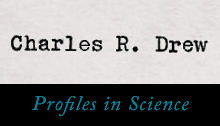Education
Higher Education Modules
Life after Death: Dr. Charles Drew, Civil Rights, and the Legacy of Race
Class 6: Life after Death for Dr. Charles Drew
Introduction
The sixth and final class delves specifically into the historical rumors and memory that have come to define the legacy of Dr. Charles Drew after his death. Almost immediately after Dr. Drew died from injuries incurred from an automobile accident on a rural North Carolina road in 1950, stories began circulating that he was refused treatment at white hospitals. How ironic and tragic would it have been for the person who helped save countless lives to be denied treatment because of his race? For many African Americans, Drew's death was not only ironic but also tapped into painful personal and group experiences of segregation common during the era. Rumors can take flight as experiential truths making them important narratives of the past, also showing the particular ways in which memory and historical experience are often intertwined in our retelling of the past.
Readings
Fry, Gladys-Marie. Night Doctors in Black Folk History. Chapel Hill: University of North Carolina Press, 1975, chapter 6.
Love, Spencie. One Blood: The Death and Resurrection of Charles R. Drew. Chapel Hill: University of North Carolina Press, 1996, chapters 5-7.
Odum, Howard. Race and Rumors of Race: The American South in the Early Forties. Chapel Hill: University of North Carolina Press, 1943, Part II (Race and Rumors of Race).
Turner, Patricia A. I Heard It Through the Grapevine: Rumor in African-American Culture. Berkeley: University of California Press, 1993.
Discussion Questions
- What role do you think memory plays in how we think about the past and historical experiences? Can you think of moments in your life where a rumor seemed to take on the ring of truth?
- Rumors are often shaped by certain historical circumstances, meaning they are formed in a particular kind of "pressurized space." What were the historical circumstances that allowed for Dr. Drew’s death to take on a second life of its own?
- Does the story of Dr. Drew’s life and death change at all how you think about history and the telling (re-creation) of history?
In-Class Exercise:
The Telephone Game:
This is an exercise that many students will be familiar with in some form from high school or early college. However, it is useful in terms of how memory and rumor inform historical knowledge. Instructors might talk a bit about historical knowledge and how we "know what we know" about the past in terms of sources and various archives. You could also talk briefly about the importance of cross-validating sources from the past as much as possible while continuing to emphasize that history is not only about what we know and think we know, but also about subjective truths that are often not found in "traditional" sources.
How It Works
Call one student to the front of the class and give them a sentence to silently memorize for 10 to 15 seconds. An example could be the following sentence from Peter Novick's That Noble Dream: The "Objectivity Question" and the American Historical Profession: "Historical objectivity is not a single idea, but rather a sprawling collection of assumptions." The student at the front of the class is then given instructions to whisper the sentence to their fellow student sitting in the first corner seat. Each student will then listen and whisper the sentence to their classmates sitting behind or in front of them going up and down rows until the sentence reaches the opposite corner of the classroom. At this point compare what the last student heard with the composition of the original sentence. (Author's note: the sentence has never made it through intact in my course which, of course, is the point!)
Students normally begin trying to point out where the miscommunication or breakdown occurred, giving you the opportunity to make final points about memory and history. This is an exercise that only works in a certain kind of classroom setting that is not too large or too small. Also, if done early enough in the semester it also serves the purpose of being a great ice-breaker for students.


